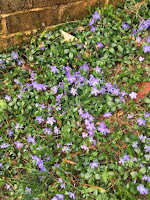When mowing is no longer an option.
Frankly, I’ve not had to mow a grassy slope since I left East Tennessee three dozen years ago. But a homeowner’s recent question got me to thinking about it again. I remember well the difficulty of pushing a lawnmower up and chasing it down, or maneuvering it across an embankment. An older neighbor used to tie a rope to the handle of his mower, then let it down and pull it up the grade repeatedly to get the job done. Neither method was ideal.
Lawn grass is popular because it covers quickly, and usually controls erosion effectively. But mowing it is the problem. There might be better ways to landscape a slope. However, a few problems would need to be solved: erosion (drainage and hillside stabilization), plant selection, and usage (function). To quote the architect, Louis Sullivan, “form ever follows function.” Here are a few.
Build a retaining wall
Retaining walls serve two purposes: to control erosion, and to modify the grade. After constructing the wall, the up-slope area is back-filled to level-out the grade (more or less), so all purposes are achieved. A grand variation of the retaining wall comes to mind that was used on great French, Scottish and English estates - the HA-HA. The retaining wall was built (as mentioned above), and the lower area was leveled out (more or less). This provided a clear view across the top of the wall to the vista beyond. It kept sheep and cattle from roaming across the lawn and pooping. It looked as though the wall wasn’t even there, until one attempted to run across the lawn and – surprise – suddenly dropped out of sight. HAHA!!!
A grand variation of the retaining wall comes to mind that was used on great French, Scottish and English estates - the HA-HA. The retaining wall was built (as mentioned above), and the lower area was leveled out (more or less). This provided a clear view across the top of the wall to the vista beyond. It kept sheep and cattle from roaming across the lawn and pooping. It looked as though the wall wasn’t even there, until one attempted to run across the lawn and – surprise – suddenly dropped out of sight. HAHA!!!Build terraces
 Terraces are basically a series of lower retaining walls made by digging into the hillside to make flat beds. Each bed being lower than the one above. This method is as old as the hills, if you’ll excuse the pun. Farmers worldwide have used these. The most notable are the rice terraces of Asia.
Terraces are basically a series of lower retaining walls made by digging into the hillside to make flat beds. Each bed being lower than the one above. This method is as old as the hills, if you’ll excuse the pun. Farmers worldwide have used these. The most notable are the rice terraces of Asia.Each level of your terraces may provide several areas for herb and flower gardens, shrub beds, wall plantings, and even seating areas. The terraces can be interconnected with a series of steps for easy access.
If your site is not too steep, you might elect to dispense with the terrace walls, but plant rows of deep-rooted shrubs and ground covers to hold the terraces in place.
Provide drainage
 Whenever soil is disturbed, the hydrologic aspect of the site is changed. Where water once flowed, it flows elsewhere, or nowhere. Something has to be done about the water to prevent gullies from forming due to rapid water flow, or puddles if it goes nowhere. Certainly, drainage tiles or pipes can mitigate the problem, but more attractive solutions might include dry creek or stream beds filled with rocks to direct water flow downward, or rain gardens to catch the water and let it percolate into the soil.
Whenever soil is disturbed, the hydrologic aspect of the site is changed. Where water once flowed, it flows elsewhere, or nowhere. Something has to be done about the water to prevent gullies from forming due to rapid water flow, or puddles if it goes nowhere. Certainly, drainage tiles or pipes can mitigate the problem, but more attractive solutions might include dry creek or stream beds filled with rocks to direct water flow downward, or rain gardens to catch the water and let it percolate into the soil.Plant the hillside
If you don’t intend to use it for any other purpose, you can simply plant the hillside with deep-rooted species. A combination could include shrubs, herbs, ground cover perennials, vines and grasses. Drought-tolerant species such as junipers, lantana, echinacea, yarrow, ivies, liriope, vinca and creeping phlox would be good selections for the dryer, upper areas of the slope. Moisture-loving species such as daylilies, rudbeckia, liriope (again) and Rubus should be planted nearer the middle and bottom. If water tends to stand in some of the lower areas, bog-type plants such as Siberian iris, sedges and Japanese Sweet Flag would be appropriate. Perhaps there are plants native to your area that would do the trick.When the problems of drainage (erosion and hillside stabilization) and plant selection have been solved, your maintenance problems should be very much reduced.
Return to GoGardenNow.com.








